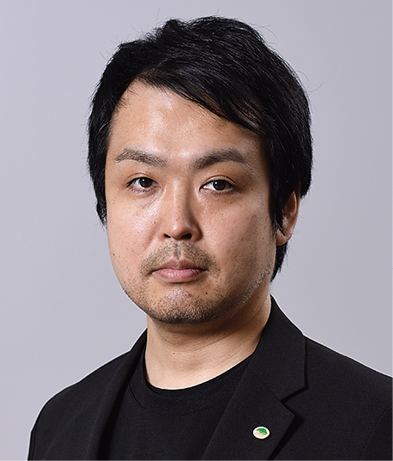COVER STORY:ACTIVITIES 2
Overcoming the Challenges of Global Co-creation
GlobalLogic, a leading company in the digital engineering industry, joined the Hitachi Group in July 2021. Since then, Hitachi and GlobalLogic have been steadily integrating their respective strengths and working on DX for both customers and Hitachi itself. Why is digital engineering so important for promoting DX? In this article, key Hitachi people speak with Rohitash Singh, Senior Vice President of GlobalLogic.
 Rohitash Singh
Rohitash Singh
Senior Vice President, (CTO Office, Advisory, Practices, Solutioning), GlobalLogic Inc.
 Hiroyuki Narumi
Hiroyuki Narumi
Project Support Department, GL Japan Business Operation, Applications Services Division, Digital Engineering Business Unit, Hitachi, Ltd.
 Yasuyuki Kowata
Yasuyuki Kowata
Design Studio, Data & Design, Digital Engineering Business Unit, Hitachi, Ltd.
Singh:We, GlobalLogic, joined Hitachi Group in July 2021 and we have started co-creation activities to achieve digital transformation (DX) in Hitachi Group companies and business units, as well as their customers, while trying to achieve our growth. I lead our CTO Office, Advisory, Practices, Solutioning (CAPS) organization at GlobalLogic at our headquarters in San Jose. I do not have a lot of experience in Japan, but to set up a team here in Japan, I have learned and have taken part in some customer conversations. It is a very interesting society and a very interesting customer base as well.
Narumi:I joined the team for the initiation phase of GlobalLogic Japan, which was established in April 2021, and I am currently working on that as a project manager mainly to serve customers. Hitachi, Ltd. is supporting GlobalLogic Japan with project execution and sales activities. Data & Design and the Lumada Innovation Hub Tokyo (LIHT) members also support GlobalLogic Japan in the advisory phase*1. For example, Mr. Kowata from Data & Design is a designer and he joins us at the very beginning of the project and then in making a concrete plan and in work activities for the project. And on the other hand, I watch over the entire process and manage the GlobalLogic Japan team members, including onsite and offsite team members, client’s expectations, and actual deliverables. That is the global team of Hitachi and GlobalLogic, which is creating and providing value to customers.
Kowata:I am working as a design strategist in the Design Studio of Data & Design in Hitachi. Actually, I recently joined Hitachi last October and, before that, I bridged the Japanese clients and designers, and also the global designers, and have worked as a consultant to identify the client challenges and then make proposals and plans. In many cases, it is really difficult for Japanese clients to identify their challenges. There are so many siloed organizations and also really limited communication on the client side. Why do they have to work on DX? Why is digital engineering important to promote DX? We need to provide these kinds of clarifications.
Narumi:The first question we address is why digital engineering is important to promote DX. One reason is that digital engineering is a very agile, iterative process. In digital engineering, we provide a clear picture of how to approach the customer challenges or the market needs in design processes while taking feedback from the market or the customer and reflecting that in products or ideas in engineering processes. With this cycle, customers can speedily invest in new business ideas or concepts while minimizing costs.
Kowata:We have two major elements in digital engineering; design and engineering. However, the design team and the engineering team are usually divided. In the collaboration with GlobalLogic, it is important that both Hitachi and GlobalLogic provide their own experience and knowledge to bridge this kind of divide.
Singh:You are right. We acquired METHOD, the strategic design arm, back in 2011, and we spent six years to integrate the design people to work together with the engineering people, and then the data people as well.
How to drive growth with our customers is about two things. The first is to make the existing set of products and services better and more sticky. Second, DX lets the customer launch new products and services, which they otherwise could not have. For example, Hilti, a manufacturer of tools, transformed itself into a different kind of digital business with asset management and leasing. Pearson, which used to be a book publisher, transformed their whole business into a learning platform. Those are the two major examples of how DX can drive growth for customers.
However, we need to be careful about how we use the term DX, because it means different things to different companies based on where they are in their lifecycle. What we can do is to make sure we talk with the customers, understanding where they are, give them ideas, and then try to offer an appropriate DX program for each customer. Within any industry, different companies have different views. In the same vertical you might find companies that are forward thinking and advanced in their thinking, and then you might find companies that are much more traditional and not willing to make the change. It is important to distinguish those differences in the early stages of the cycle so that we can utilize digital engineering and DX with them in the right way.
Kowata:We have to distinguish what value the customer wants to provide to its customers, or what vision it wants to achieve in the future before starting digital engineering. However, there are also challenges to executing digital engineering with team members across the world, because it requires close communication between team members. One simple example of the challenges is the time zone difference. Finding the middle point, for example between Japan, India, and the USA is difficult. Styles of communication, such as conversations, meetings, or emails also differ depending on the country. And, as I already have mentioned, the boundaries between the engineering and design teams are still there. However, mutual understanding between all stakeholders is quite important in digital engineering. This is really challenging.
Narumi:We also have cultural differences between Japan and other foreign countries. For example, Japanese customers always expect very detailed deliverables or documents before making decisions because Japanese business culture is very consensus-based. On the other hand, US or European culture is more casual and a minimum level of information is all right to move forward. So, in order to fill the gap with a customer’s expectations, we usually ask our US or European team members to create documents. But typically, they ask “why?” Because they have different ideas about how to reach consensus on the need for detailed documentation in order to proceed with a project and the necessity of providing explanations in advance. Those differences in business culture might be a big challenge, but I would say it definitely can be solved through co-creation from now on.
Singh:We see a considerable difference of opinion between Europe and North America as well. In North America, decisions in business are usually made from the top down. Therefore, top executives can make risky decisions with a minimal amount of information. As a result, you’ll find the proportion of failed projects to be very high in North America. There is a kind of North American business culture like, “Let’s move forward with the risk, but we want to fail fast and then move on so that the cost of failure is not high.” On the other hand, when we look at Europe, we find them to be a little bit more risk averse. Decisions are usually made in principle by top management, but it requires the support of middle management as well. What we are finding in Japan is a much more risk-averse approach. They want to understand more deeply what a decision means, what its merits/demerits are. Also, because customers have to consider budgets, we need the ability to provide more concrete estimations with less variance, even when things are undefined.
In this way there are some cultural differences between us, however, what is important is that we should be an advisor for our customers, not simply a DX executor. It is really important for us to provide sincere, candid advice and to build trust with them in order to promote DX. We have to learn more about Japanese business culture, but we would like to adapt it while changing ourselves.
Kowata:Japanese companies seem to have a weakness in identifying visions or challenges in their business. That is why we need detailed explanations or documents to reach a consensus over the processes to achieve a goal. To clearly understand what they want to do and why and how to do that, it is very important to join the project from a very early stage. Sharing highly confidential information with external companies is really challenging for Japanese companies. So building trust and communicating with C-suite members is quite important.
Singh:For that matter, I think we can leverage Hitachi’s internal experience as well. Many Hitachi companies and business units are now embracing DX internally in different ways. They will certainly be a model to other Japanese customers in the next few years.
Narumi:When we have a successful model case internally at Hitachi, that might be a huge trigger to Japanese customers to think about promoting DX. Whereas US companies want to succeed before anyone else and actively seek out that possibility, many Japanese companies prefer to apply successful examples to themselves so as not to be the first to fail. They are usually very cautious, but it is the core business mindset in Japan. So, we need to improve the process instead in order to resolve that mindset.
Kowata:The same can be said of development speed. In the USA or Europe, they can backcast and practice what they have to do in the short term, middle term, and long term and then, even if product development is not enough, they try to launch it and see the results. On the other hand, as Japanese companies do not want to fail, they prefer a bottom-up process, like, “We have achieved this, so what is next?”. It is quite difficult, for example, to apply new way of development such as agile engineering in that business culture.
Singh:When we started working with automotive companies in Europe, because software used in automotive products must not fail to secure drivers and passengers, quality was very important, and its development lifecycle was really short. So, the challenge was how we put agile engineering into the V-model*2. We took a couple of years to do that, but finally were able to do it successfully. We don’t have to apply it as-is, in other words, there might be ways to adapt with Japanese business practices to enable us to do agile development and design work.
Narumi:I agree. So, I think pure agile processes are a little bit hard for the Japanese market. Also, from the point of view of budgets, typically Japanese clients secure the budget a year or six months prior and they cannot invest for agile-type projects on time. In addition, as Mr. Kowata has already mentioned, Japanese clients always require super-high quality. Therefore, we should adjust our quality assurance (QA) work as well. To make extensive use of GlobalLogic’s huge capabilities, I wish we could tweak pure agile methodologies just a little bit, so that we can fit them to Japanese clients.
Kowata:So, as you two mentioned, Japanese clients need a success story and there are many small teams in their organization. So I think it is quite effective to show small successes first internally with agile processes.
Narumi:By the way, I would like to ask Mr. Singh about educational programs in our organization. I think there are also some cultural differences in terms of those.
Singh:You have to have people be cross-trained beyond their fields, especially in the IT and software industry, because technologies change very quickly. At GlobalLogic, we have the Talent 2.0 educational program with academies where we can cross-train our people. If we cross-train our people, it is easier for us to deploy them into different projects. So there are of course some business aspects to education in a company. In North America, it is very easy for companies to lay off employees who are not relevant to their business anymore. On the other hand, it is also easy for talented employees to find some other job. In that sense, a lot of responsibility is on the employees to educate themselves and keep their skills current. There is no safety net for employees to ensure their job.
Narumi:I think in Japan, there is a strong safety net which is called “Teinen.” If you join a company, you can work until maybe 60 years old regardless of whether you have enough skills or not. Sometimes employees feel like they are struggling to gain new skills by themselves because they cannot create a clear picture of their careers. There might be some people who find it hard to adapt to the fast-changing market or technologies. Japanese companies’ educational programs can be considered as a kind of safety net for their employees so that they can easily develop their career or skills.
Kowata:In Japanese companies, where you belong to is more important. When you introduce yourself, you start with the company name first like, “I am from this company, and my name is this.” But maybe in Europe or the USA, it is the opposite. This is the first time for me joining a big company like Hitachi and I have had so much training. But, I felt that much of it was not about skills and more about people management or some processes or securities which are very applicable for employees within this company only.
Also, moving between the divisions in Japanese companies really makes a big impact. For example, I worked with a client for three years, and suddenly the person in charge moved to another division. His successor did not know much about our history or collaboration with us—and then, all the projects stopped. Especially in big companies, I have heard that people have to move to new divisions every three or four years. If so, gaining skills and knowledge transfer are quite important. But there is a severe lack of time. I think that is why the superior designers or engineers do not stay in Japanese companies.
Narumi:I feel that Japanese educational programs tend to make employees generalists, not specialists. In order to become specialists, we need to outsource training by ourselves. However, GlobalLogic has thousands of specialists to give us a lot of confidence in achieving DX for customers. I think it will be great if we can learn a different mindset through educational collaboration between Hitachi and GlobalLogic, though it will not be a win-win situation immediately.
Narumi:I think collaboration between Hitachi and GlobalLogic brings great diversity to the Japanese market and customers. Diversity here means not only a difference in culture or country, but is also more about technical or business aspects. GlobalLogic has vast experience and capabilities in chip-to-cloud DX and design, and they will cover Hitachi’s business capabilities to support customers, which was not enough before, and will make it possible to deliver new value to customers in many fields of industry. Now we can do what we could not achieve very much in the past by utilizing the capabilities of both companies. We would like to utilize these new capabilities to support our customers to transform their business or improve their products/services.
Singh:In the future, we can definitely target fields in which Hitachi already has earned good respect, like energy and railway systems. If we can drive internal business transformation and convince the employees in Hitachi Group companies or business units in those field that “This is the way to achieve DX,” then they can take it to their customers. I think there is enough business in just these areas if we do it well and we can expect significant growth. It is not easy to change a way of doing business that has existed for decades, so it is important for us to find the places where change is already coming and support the change.
Kowata:I agree with you. DX at Hitachi is quite important as it is said that digital consultancy companies should do consultancy for themselves. So we have to do that from our side first, and then realize good success stories and provide them to customers by having conversations with them and gaining their trust. Now, some Hitachi teams are learning from GlobalLogic, gaining extensive experience in global activities and advanced digital engineering technologies, but we have to be able to do it by ourselves, and then bridge GlobalLogic and customers to provide new capabilities. To achieve this mid-term goal, we would like to continue our co-creation activities.